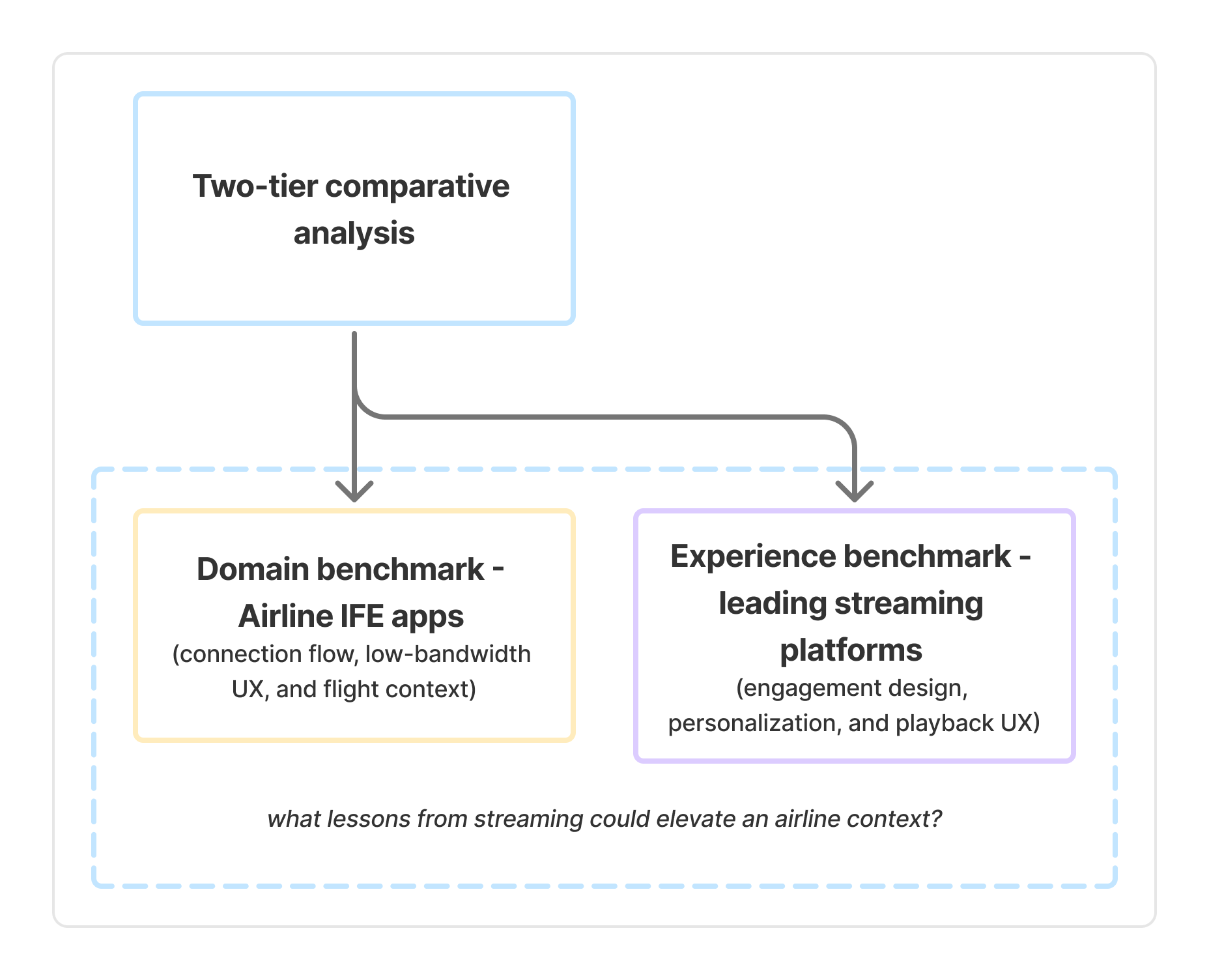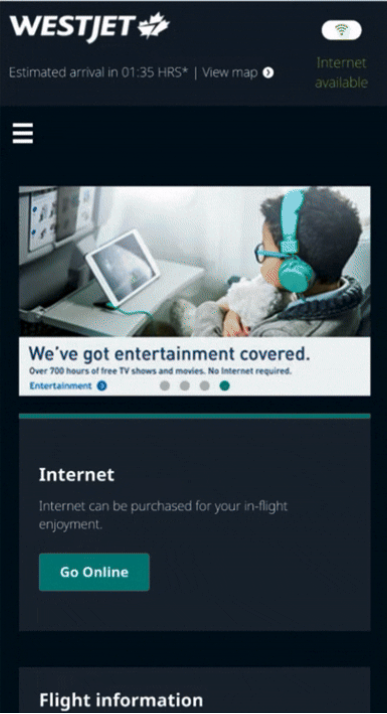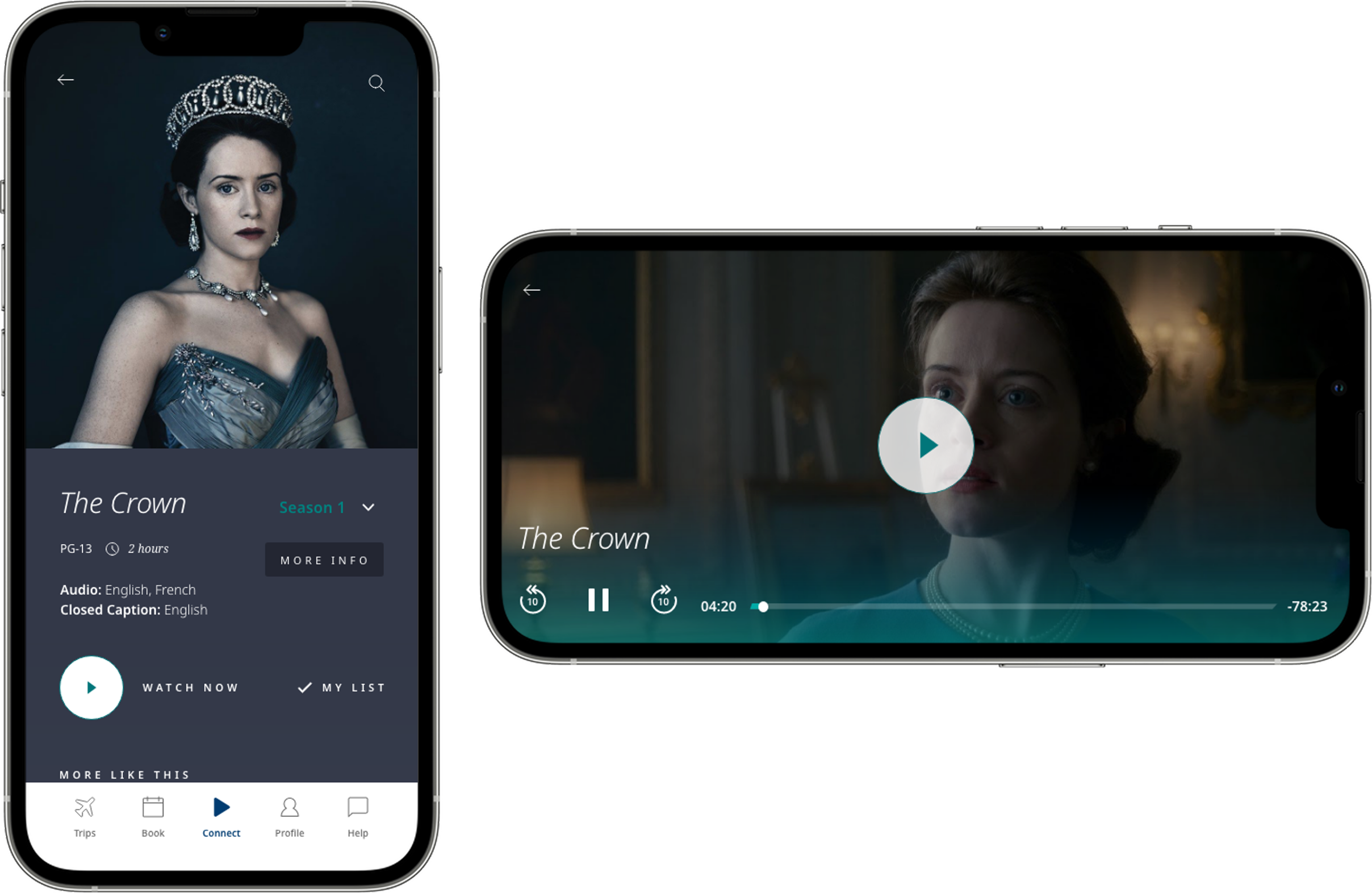WestJet In-flight Experience, The Ultimate Digital Companion: Empowering Users to Control Entertainment and Connectivity
Designing a Seamless Experience: Onboard, enjoy movies, TV shows, games, internet access, and more...
Impact
As a result of this strategic overhaul of the mobile app, we are positioned to expand WestJet's competitive presence among premium airlines. By delivering a premium, contemporary, and lightweight design, we directly enhance the In-flight Entertainment experience,the app's most frequently used feature to meet the critical need for accessible, offline entertainment during long-haul flights at 37,000 feet, thereby strengthening a cherished in-flight connection for WestJet guests.
Role
Product vision, end-to-end UX design, user research, interaction design, prototyping, usability testing, visual design, cross-functional collaboration
Team
Product owner, Android and iOS developers, user experience research team
Understanding the Current Landscape
My immediate step was to delve into our existing in-flight entertainment, WestJet Connect. I compiled screenshots to fully grasp the user experience. This foundation allowed me to brainstorm enhancements, aiming for a more premium feel that could rival top-tier airline apps.
While innovation was vital, I recognized the importance of some continuity. Since guests were accustomed to the WestJet app's Connect layout, a total overhaul wasn't ideal. Retaining certain familiar elements ensured users wouldn't be starting their understanding from ground zero.
WestJet Connect pre re-design ~2019
Key Insights
The current interfaces felt outdated, despite clearly representing the WestJet brand, an airline's in-flight experience is pivotal; it should mirror the brand's excellence in customer service. The digital presence needed to be consistent with the in-person reputation.
Constraints
Gaining access to other airlines' in-flight entertainment was challenging, especially with COVID-19 limiting travel. This meant my reference mostly comprised of platforms focused on movies and TV shows. Yet, since a majority of our guests primarily use the in-flight entertainment for such content, I felt assured in capturing the essence of 75% of our platform.
Competitive and experience benchmarking
To understand how passengers engage with in-flight entertainment across the industry, I reviewed the mobile experiences of major airlines including Delta, American Airlines, Air Canada, and Emirates. The analysis focused on connection onboarding, content discovery, and playback continuity, the key moments influencing passenger satisfaction and ease of use.
I looked horizontally at airline apps, but also vertically at best-in-class entertainment UX patterns from streaming leaders.
*Based on available public documentation, user reviews and flight-experience posts; experiences may vary by aircraft type.
Visual systems vary widely, but few strike a balance between aesthetics, accessibility, and clarity under travel conditions.
Key takeaways:
Fragmented connection flows, often dependent on web portals.
Minimal personalization — “one size fits all” content discovery.
Playback often fails gracefully; poor recovery after connectivity loss.
Visual design varies widely; accessibility inconsistencies common.
The WestJet redesign opportunity lies in creating a calming, premium, and highly legible interface that holds up in low light and turbulence environments.
Aiming to reflect the WestJet identity - friendly and helpful - I looked to industry giants: Netflix and Disney+. Their vast R&D and user feedback provided quick insights into entertainment platform preferences.
Unlike airline apps, streaming leaders excel at anticipation (predicting what the user wants next) and continuity (keeping users oriented and in flow). The WestJet redesign could borrow these qualities, while adapting them to the constraints of offline or intermittent connectivity.
I then mapped the end-to-end journey passengers take to access in-flight entertainment on their personal devices, from downloading the WestJet app before boarding to connecting to the in-flight Wi-Fi and exploring available options like movies, TV shows, games, news, and flight information.
This mapping helped surface key friction points: passengers often struggled with unclear connection instructions, difficulty resuming playback after connectivity drops, and limited offline fallback options. These insights framed early design opportunities focused on clarity, predictability, and effortless recovery during flight.
Putting real users at the heart of every decision
Based off the audit of the existing user experience as well as performing the SWOT analysis, I landed on two personas to focus the design problem around. I chose the teal tier WestJet guest, to ensure representation of the most common tier level for guests travelling WestJet, as well as the platinum tier WestJet guest to contrast wants, and needs and ensure the re-design was addressing guests of different backgrounds with varying requirements.
Teal tier WestJet guest
Travel Frequency: Occasional
Once on board, I wish to access the In-flight entertainment promptly when available. I expect movies to be easily discoverable with a wide selection. The app's navigation should be intuitive and reminiscent of entertainment platforms I've encountered on other flights. With limited flight duration, like a couple of hours, I don't want to waste time searching; I might just fit in one movie.
Platinum tier WestJet guest
Travel Frequency: Frequent/business
On flights, movies aren't my priority. I primarily use In-flight entertainment for the flight-map and to buy internet – staying prepped for work upon landing. I want instant access to flight duration and time remaining. With flight attendants not always available, I rely on the app for flight info. I wish for a seamless transition from losing service to quickly accessing the internet onboard.
I engaged users early on to confirm and refine insights from my analysis
50 WestJet guests from a variety of WestJet rewards tiers (teal, silver, gold, platinum) were selected for user interviews.
WestJet guests were asked these questions...
What parts of the in-flight entertainment do you like the most? Why?
What parts of the in-flight entertainment did you use the least? Why?
What do you think about the way features and information are presented?
How would you rate the WestJet in-flight entertainment compared to other airlines?
Four common themes presented themselves. These themes indicated what WestJet guests valued from in-flight entertainment apps.
Ease of use and time to task
New and relevant content
Consistent and predictable search capabilities/ navigation
WestJet guests satisfaction and likelihood to recommend the airline for longer flights had a strong correlation to the in-flight offerings and of course the in-flight entertainment.
Personalization, feeling valued and recognized
Sample of testing prompts setup
By diving into both airline in-flight entertainment and top streaming platforms, we uncovered how users truly engage with digital experiences - insights that fuel the goals of our redesign, aiming to transform the passenger journey into something intuitive, immersive, and delightfully seamless.
Experience principles
These insights helped us pinpoint the core opportunities to elevate the passenger journey, which we framed as a guiding design challenge:
How might we…
enhance the in-flight entertainment experience to not only look and feel premium, but also be highly usable, adaptable and personalized?
Design an experience that more closely represented our guests perception of us; friendly, outgoing, energetic, always willing to help out
Create a consistent, and seamless look and feel that represents WestJet’s brand and values by implementing personable and relatable language/ tone.
Refine the color strategy by repositioning teal as an accent to support, rather than lead, the palette, while introducing a new tone that better conveys a premium experience- guided by guest feedback and competitive insights
From insight to definition: translating expectations into a premium WestJet experience
With a clear understanding of guest expectations and the broader entertainment landscape, the next step was defining what “premium” should mean for WestJet’s digital IFE. The introduction of the Dreamliner seat-back UI marked a major shift toward calmer colours, cleaner layouts, and a more sophisticated onboard experience. Instead of duplicating that interface, I used it as a reference point to ensure cohesion across touch points. By translating its core cues, muted navy, deeper neutrals, reduced teal, increased whitespace, and more intentional interaction pacing, into a flexible mobile-first system, the digital experience now mirrors the elevated direction introduced onboard.
As a team, we prioritized:
predictable content discovery
simplified navigation models
personalization that feels warm, not overwhelming
visual refinement aligned to WestJet’s evolving brand
Over things like:
major rearchitecture of content platform
expanding feature inventory
layered customization UI
heavy motion design
Designing a welcome that feels personal
BEFORE
AFTER
The Connect screen becomes the guest’s first impression, a calm, confident entry point that immediately feels familiar.
By pairing clear hierarchy with gentle personalization (“David, how can we help you relax?”) and a bold View Entertainment button, the experience signals ease from the very first tap.
Instead of the fragmented, text-heavy flows common in airline apps, this moment sets a premium, human tone and guides guests straight into discovery with zero friction.
Focus:
Warm personalization: Moves beyond generic greetings to create a “you’re taken care of” tone.
Purposeful simplicity: Eliminates the friction of multi-step web portal flows.
Predictable interaction model: Aligns with entertainment giants, one tap in, no ambiguity.
Premium spacing + reduced teal: Early visual cue of the brand’s shift toward elevated service, while maintaining brand recognition.
Access a variety of features and services in a single tap
The carousel uses the same anticipation logic guests are used to from major streaming platforms.
It surfaces what matters most right now, from fresh meal options to a featured game or the flight map, paired with a single, context-aware call-to-action (“View menu,” “View entertainment,” “View flight map”).
No digging, no decisions, just one tap into the moment.
Focus:
Anticipatory design: Surfaces the most relevant experience without requiring choice.
Emotionally warm microcopy: Friendly labels like “Play some games” humanize the interaction.
Single-tap access: Eliminates navigation friction seen in competitor airline apps.
Brand-aligned palette: Neutral colours with the teal call-to-action buttons maintain the premium visual tone.
Accessible contrast: Ensures clarity even in dim cabins or turbulence.
Your journey, your entertainment
BEFORE
The Entertainment section transforms in-flight downtime into a seamless moment of discovery.
With clear, bold calls to action, “Movies,” “TV Series,” “Radio”, “Games” and subtle personalization (“David, connect to your world while in ours”), guests are guided directly to movies, TV, radio, and games with a single tap.
By removing cluttered menus and multi-step flows, this screen replaces friction with delight, creating an approachable, premium experience that feels familiar yet elevated.
AFTER
Focus:
Warm personalization: Moves beyond generic greetings to make each guest feel known and cared for.
Purposeful simplicity: Streamlined access to entertainment removes unnecessary steps, keeping the journey effortless.
Predictable interaction model: Aligns with leading streaming apps, one tap to access, no ambiguity.
Premium spacing + refined colour palette: Subtle design cues signal a more sophisticated, elevated in-flight experience while keeping brand recognition intact with the seat back experience.
My list, always ready
With My List, guests can save movies, shows, radio stations, and games for easy access anytime during their journey.
Leveraging familiar patterns from popular streaming platforms, the feature feels instantly intuitive, tap to add, tap to play, reducing friction and letting guests focus on what matters: enjoying their flight.
By creating a personal space for preferred content, the experience feels curated, effortless, and unmistakably human-centered, bringing a touch of home into the sky.
Focus:
Familiar interaction patterns: Aligns with leading streaming apps to reduce cognitive load and increase immediate usability.
Effortless curation: Quick add/remove gestures let guests easily manage their list without interrupting their experience.
Seamless cross-content experience: Works consistently across movies, TV, radio, and games, creating a unified entertainment journey.
Find relevant content for you, quickly
The detail view gives guests rich context at a glance, trailers, summaries, ratings, and related content, all in a single, clean interface.
By leveraging familiar patterns from streaming platforms, guests immediately know where to tap, what to expect, and how to start playing, turning decision-making into a smooth, enjoyable moment rather than a chore.
Focus:
Instant clarity: Prioritizes key content information, title, synopsis, preview, and actions, so guests can make quick decisions.
Familiar layout patterns: Mirrors streaming apps’ card and detail structures to create intuitive recognition.
Action-first hierarchy: “Play” or “Add to My List” buttons are bold and prominent, reducing friction.
Contextual recommendations: Related shows, movies, or games encourage discovery without overwhelming the guest.
Impact metrics
42% increase in entertainment engagement
36% faster content start time
2.3× more sessions per guest
25% of guests adopted My List within week one
18% higher IFE satisfaction scores
Beyond the MVP release
While the MVP focused on creating a seamless, premium entertainment experience, several exciting opportunities surfaced that could further elevate the in-flight entertainment.
Destination Guide: Imagine integrating curated destination content directly into the app, travel tips, local experiences, and “must-see” highlights—so guests can start exploring before landing.
In-Flight Ordering: A streamlined food and beverage ordering experience could bring convenience and personalization to every seat, connecting service with entertainment in one cohesive flow.
Pre-Save / My List Expansion: Giving guests the ability to add shows, movies, and games to My List before they’re available in-flight would create anticipation and a more tailored experience.
Each of these concepts extends the foundations laid in the MVP:
A more premium experience that feels intentional and elevated
A digital touchpoint that’s unmistakably WestJet in tone and warmth
A focus on delight, because happy guests become loyal guests
A digital experience that supports, and amplifies, the care delivered in person
These explorations remain mockups for now, but they reveal a clear path toward a richer, more unified WestJet Connect ecosystem that supports guests from takeoff to touchdown.

































